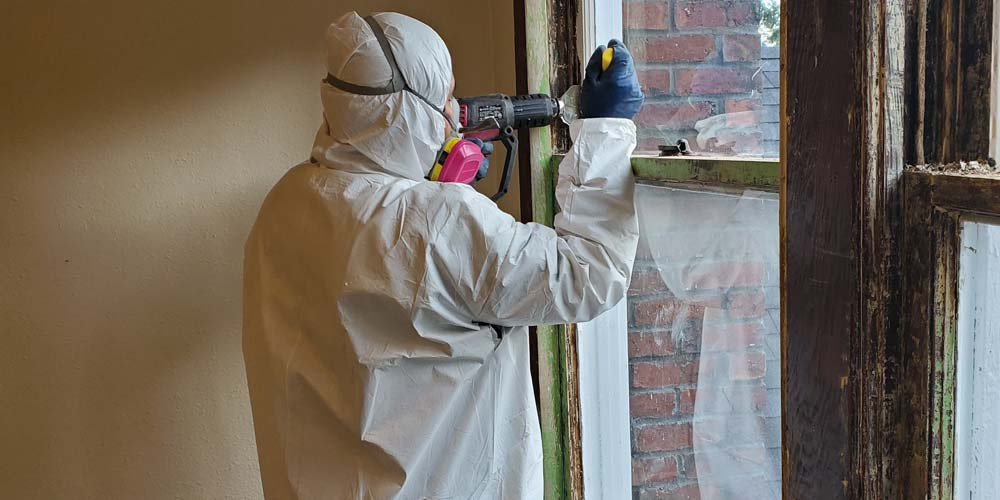Lead Paint Removal Service-- NYC's Trusted Solutions for Lead Security
Lead Paint Removal Service-- NYC's Trusted Solutions for Lead Security
Blog Article
Comprehensive Overview on Effective Lead Offense Elimination Strategies
In the realm of ecological safety and security, addressing lead violations demands a precise and organized strategy. This comprehensive guide begins by highlighting the critical initial steps of identifying lead hazards through advanced assessment and testing methods. Techniques such as XRF analysis and dust wipe sampling are essential in identifying contamination sources. Additionally, the guide elaborates on the significance of adhering to stringent safety and security protocols throughout the removal procedure, including making use of correct PPE and isolating influenced locations (Lead Paint Removal Company). The succeeding sections promise to discuss post-removal confirmation and precautionary strategies, ensuring lasting safety and security and compliance. Discover the intricate information that make these methods not just reliable yet crucial.
Recognizing Lead Hazards
Identifying lead risks is an important initial action in minimizing the risks associated with lead exposure. Lead, a hazardous steel, can be present in different ecological tools, consisting of paint, soil, water, and dirt.
The initial phase in recognizing lead threats entails recognizing usual lead sources within the built atmosphere. Structures constructed prior to 1978 are specifically prone due to the widespread use lead-based paint during that duration. In addition, soil contamination can take place from degrading outside paint, industrial exhausts, or historical use of leaded gas.
Another substantial source is lead piping and plumbing fixtures, which can leach lead right into drinking water. Durable goods such as playthings, porcelains, and imported products may likewise consist of hazardous lead degrees. Significantly, occupational atmospheres and pastimes entailing lead can track pollutants right into homes.
Evaluation and Screening
When attending to lead dangers, efficient analysis and screening are vital. This important step makes certain the identification and metrology of lead visibility, thus leading subsequent removal efforts. Preliminary assessment commonly includes a visual assessment to identify possible lead sources, such as degrading paint or infected dirt. This is matched by even more extensive screening methods to determine the level of contamination.

Dirt clean tasting is one more essential method, particularly in domestic settings. By accumulating examples from floorings, windowsills, and other surface areas, this technique offers understandings into possible direct exposure dangers. Dirt screening around building boundaries is important to detect lead contamination that might present dangers, particularly to children.
Safe Removal Procedures
Upon finishing thorough evaluation and testing, applying risk-free removal treatments is the following essential stage in dealing with lead dangers. This process ensures that lead-contaminated products are effectively and securely eradicated, minimizing risk to both employees and citizens. The primary step includes separating the affected area making use of plastic bed linen and appropriate securing strategies to protect against the spread of lead dirt.
Employees need to put on ideal individual protective equipment (PPE), consisting of respirators, handwear covers, and non reusable coveralls, to mitigate exposure. Using specialized tools and damp techniques, such as wet sanding or utilizing HEPA-filtered vacuums, decreases the dispersion of lead fragments. It is crucial to avoid completely dry sanding or abrasive blasting, as these methods can generate hazardous lead dust.
Waste disposal is one more important component; all infected products should be firmly nabbed and classified according to EPA and regional regulations. Furthermore, comprehensive cleansing of the workspace with HEPA vacuum cleaners and wet cleaning guarantees the elimination of residual lead bits.
Post-Removal Confirmation

Verification of effective lead removal, understood as post-removal confirmation, is crucial to ensure the security and habitability of the remediated location. This procedure involves a series of careful assessments and tests created to identify any residual lead bits that might pose health dangers. The preliminary step typically consists of an aesthetic inspection to analyze the conclusion and top quality of the removal job. This examination ensures that all known sources of lead have actually been resolved and that no noticeable signs of contamination continue to be.
Complying with the visual examination, environmental tasting is performed. This includes gathering dust, dirt, and in some cases water examples from the remediated area. Recognized research laboratories examine this content these samples to determine lead degrees, ensuring they drop below the security thresholds established by regulative bodies such as the Epa (EPA)
In enhancement, air quality testing might be done to identify air-borne lead fragments, specifically in instances where extensive lead-based paint elimination or renovation has happened. The results of these examinations supply quantitative information validating that the lead degrees are within acceptable restrictions.
Eventually, post-removal verification functions as a crucial checkpoint, confirming the performance of the lead reduction initiatives and protecting the health and wellness of owners and site visitors.
Safety Nets and Maintenance

A vital safety net consists of using lead-safe licensed contractors for any kind of remodelling, repair work, or painting activities. These professionals are trained in methods that reduce lead dust and particles. In addition, keeping coloured surface areas to stay clear of breaking or peeling off is important, as weakening paint can launch lead fragments right into the atmosphere.
Educational efforts targeting residential property proprietors and lessees regarding the risks of lead and the value of reporting any type of possible threats can further boost precautionary initiatives. Routine cleansing using HEPA vacuums and damp wiping methods can dramatically decrease lead dust accumulation.
Verdict
In summary, effective lead violation removal requires a thorough method incorporating complete analysis, Continue exact screening, and rigid removal procedures. Making certain safety via proper seclusion and individual protective tools stays critical. Post-removal confirmation by means of ecological tasting and air quality screening confirms compliance with well-known safety and security criteria. Furthermore, continuous examinations and upkeep are vital to minimize future lead dangers, thus safeguarding public health and wellness and ensuring sustained compliance with regulative demands.
Report this page